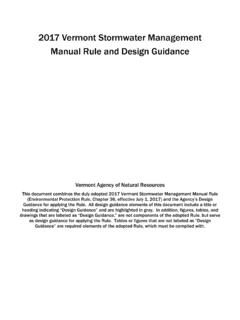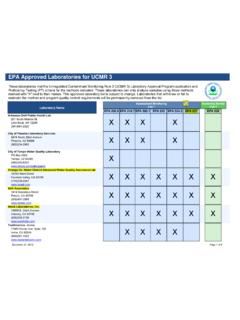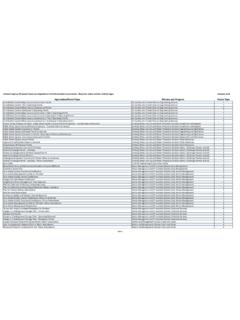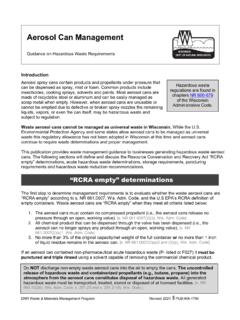Transcription of Asset Management: A Guide For Water and Wastewater …
1 2006 EditionAsset management : A GuideFor Water and WastewaterSystems2006 EditionPrepared by:Environmental Finance CenterNew Mexico Tech2006 EditioniAcknowledgementsThe information presented in this document has been compiled from various overall basis for Asset management presented in this document is the approach ofAustralia and New Zealand as presented in the International Infrastructure ManagementManual Version , 2002. This information was supplemented with informationincluded in EPA s Advanced Asset management Training program which is conductedby EPA and GHD Inc.
2 This training program is based on the Australia/New Zealandmethodology that has been tailored for the United information for this manual was gained through site visits and interviews thatthe EFC Director held with many individuals involved with Asset management inAustralia and New Zealand. These interviews were held with Asset managementpersonnel connected with utilities, governmental entities, consulting firms, associations,users groups, and elected officials. The specific focus of the interviews was how totailor the Asset management principles from larger systems to smaller gathered from these interviews and discussions has been incorporated intothis , the NM EFC has been providing Asset management training to Water andwastewater utilities across the state and in several other states and has been workingdirectly with three smallwater systems in New Mexico to develop Asset managementplans.
3 The experiences gained from working directly with systems and fromdiscussions at the training sessions has also been incorporated into this EditioniiPurpose and Need for GuideNew Mexico s drinking Water and Wastewater systems will need to implement newadministrative systems and management tools to allow them to adapt to the increasedregulatory requirements and environmental complexities they face. These new tools willallow the systems to operate on a business model for long term sustainability to helpaddress the issues of: new and stricter regulatory requirements, growing populations,increased service demands, limited Water supplies, a highly variable climate, aginginfrastructure, and limited state and federal estimates for Water and Wastewater system needs in New Mexico are severalbillion dollars, while the existing state and federal funding sources can only meet afraction of this need.
4 These sources of funding are not expected to increase, and inmany cases, are declining. Therefore, approaches to reducing the gap between what isneeded and what funds are available will need to be adopted. In addition, funders wantassurance that the investments they make in Water and Wastewater infrastructure will beadequately managed and maintained to ensure long term sustainability and assurance will require Water and Wastewater systems to present convincingevidence that they possess adequate financial, technical, and managerial capacity toprovide the service that their customers expect, to maintain the infrastructure necessaryto provide that service.
5 And to manage the organization technically and financiallythroughout the life expectancy of the improvements being address these significant challenges, the 2005 New Mexico Legislature passedHJM86, which called for the State Engineer, in collaboration with the New MexicoEnvironment Department and other agencies, to develop criteria for Water systemplanning, performance and conservation as a condition of funding. The results of theHJM86 efforts indicated that requiring specific standards related to Water andwastewater system operation, management , and planning is the best way to ensurethatthe millions of dollars in annual state and federal funding is invested in the mostappropriate and cost-effective projects and is provided to systems that have adequatecapacity to protect that investment.
6 The report developed in response to HJM86recommended that systems adopt a business model for managing the delivery ofservices that includes: a five-year financial plan with a fully allocated rate structure; an Asset management plan; a Water accounting system with full metering; full compliance with the Safe Drinking Water Act (SDWA), the CleanWater Act (CWA), and all of the regulations of the Office of the StateEngineer and the New Mexico Environment Department; a governance structure adequate for proper management and oversight;and participation in regional efforts to collaborate on long term EditioniiiIn 2006, three Technical Assistance Providers1 and the State of New Mexico teamed-upto develop guidebooks to help Water and Wastewater systems better manage their waterresources and plan for their future.
7 The guidebooks are titled:--- Water Use Auditing:A Guide to Accurately Measure Water Use and Water Loss---Financial Planning: A Guide for Water and Wastewater Systems; and--- Asset management : A Guide for Water and Wastewater guidebooks address core issues regarding Water system sustainability: auditingwater use to reduce Water losses and increase system efficiency, financial planning andmanagement to ensure sufficient revenues to sustain operations, and assetmanagement to allow the system to provide a sustained level of service at the lowestlife cycle cost.
8 Water and Wastewater system owners, operators, managers, and boardmembers will find that these guidebooks are useful tools for assessing the currentstatus of their operations and for developing strategic plans for sustainable Water andwastewater guidebooks are intended to be used together as integrated tools for efficientmanagement to enable the system to meet future service demands and regulatoryrequirements and to provide for long-term sustainability. For example, assetmanagement is a fundamental step in determining financial resources needed tooperate the system and pay for system improvements, expansions, or Water auditing program can tie to Asset management by providing informationabout the condition of some of the buried assets.
9 The Water auditing process also tiesto Water conservation and rate setting. Because of these ties, Water and wastewatersystem personnel are encouraged to examine all three manuals before beginning theirsystem evaluation. However, the guides can be used independently, allowing a wateror Wastewater system to implement the business model incrementally, starting with thesystem smost pressing needs or starting with the easiest success. No matter how thesystem implements the practices, the ultimate goal should be incorporating all three ofthese tools into the system s standard management initial assessments are complete, findings can and should be used by keydecision makers to Guide the future of the Water or Wastewater system.
10 These are not one time activities; it will be important to reevaluate and update this informationannually or whenever the system s needs change. Over time, the use of the tools canbe increased and enhanced to support more complex and sophisticated safe and dependable supplies of drinking Water and protecting Water qualitythrough adequate Wastewater treatment is critical to maintaining New Mexico seconomic vitality and quality of life. These guidebooks should provide the tools neededby Water and Wastewater systems to actively and consistently analyze currentoperations and future needs in order to develop robust management systems and well-designed infrastructure to meet these growing Three technical assistance providers contributed to this project.









